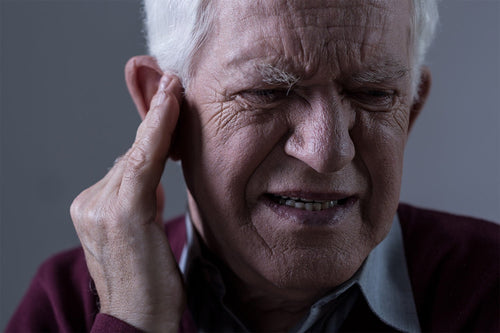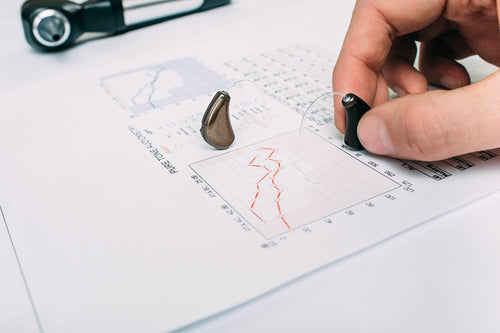When growing up, many people are taught to utilize cotton swabs to clean their ears. While you may feel like it helps your ears stay clean, the reality is that cotton swabs or any object for that matter shouldn’t be entering your ear canals at all.
If you were to ask an ENT specialist, you might be surprised that nearly all of them will agree that cotton swabs are a no-go when it comes to proper ear hygiene and earwax removal.
While you may be convinced that your ears will become clogged without the assistance of cotton swabs, in the vast majority of cases, the ears are able to handle it just fine and expel wax all on their own. Even though the ears tend to be self-cleaning, there are instances in which ear wax buildup needs to be cleaned. Too much earwax can contribute to tinnitus and even hearing loss.
With cotton swabs out of the picture, many people do not know how to get their ears cleaned. Below is a closer look at the solutions and techniques you can utilize to help remove wax buildup and have your ears be free and clear of earwax buildup.
Structures of the Ear

To understand why certain techniques are better than others, you should have an idea of what the anatomy of the ear looks like and its different components. Many people understand little about the anatomy of the ear. As a result, they might not understand why cleaning techniques utilize certain methods over others.
Outer Ear
When talking about wax accumulation and removal, this concerns only the outer ear. The outer ear consists of all of the external ear parts like the pinna and ear canal. The ear canal is a long tube that leads to a thin membrane known as the eardrum. The eardrum marks the end of the outer ear and the beginning of the middle ear.
Special cells that line the ear canal are the glands that produce earwax, also known as cerumen. Cerumen is continuously produced by these cells. Earwax traps dust and dirt and helps expel these from the ear.
Due to the internal location of the ear canal and the proximity to the jaw, older wax is able to readily flow out of the ear canal. The internal location keeps the wax melted while the movement of the jaw helps to physically move it out of the ear.
Middle Ear
The middle ear starts right behind the eardrum and consists of three tiny bones and an empty cavity known as the tympanic cavity. This cavity is home to the inner ear bones and connects to the back of the throat through structures known as the eustachian tubes.
The middle ear is responsible for transferring the movement of the eardrum to the inner ear and equalizing pressure across the eardrum. If there is a pressure differential on one side of the eardrum, it would result in a slight bulge of the eardrum and decrease its ability to hear a noise.
This is why many people experience a degree of muffled hearing on airplanes; the inner ear pressure is not the same as that in the immediate environment. What people call “popping your ears” is your middle ear reestablishing the pressure which enables you to hear sounds clearly again.
Inner Ear
The inner ear is the structure that takes the vibrational energy of sound and converts it into neural impulses that are perceived as sound within the auditory cortex of the brain. The main parts of the inner ear consist of the cochlea, semicircular canals, and auditory nerve.
The cochlea is the structure that takes in the vibrations from the middle ear bones and translates them into neural impulses. The semicircular canals are structures of the ear that don’t contribute to hearing, but they play an important role in your ability to balance.
Lastly, the auditory nerve is the bundle of nerves that transmits signals from the inner ear to the auditory cortex of the brain.
What Can You Put in Your Ear?
Now that you are more familiar with the anatomy of the ear, you can have a better understanding of the things that can go into your ear. Generally, objects like cotton swabs, hairpins, and scrapers should not be placed into your ear for cleaning.
They can puncture the thin membrane of the eardrum. Additionally, these objects can actually push earwax farther back into the canal, resulting in impacted earwax and blockage.
Rather than utilizing tools, the use of various liquids can help to break down the wax buildup. This allows it to drain from the ear, decreasing the chances of a damaged eardrum.
Here is a closer look at the types of liquid you can utilize for ear wax removal that decrease your chances of complications like tinnitus.
Peroxide Based Ear Cleaners
One of the most cost-effective and effective ear cleaning methods is the utilization of ear cleaning solutions. There are a number of solutions available, and many of them contain peroxide.
When peroxide makes contact, it releases oxygen bubbles that can help to loosen up and break up wax buildup. You may hear a temporary fizzing sensation as it loosens the excess earwax.
This OTC remedy (can be administered through a bulb syringe) is an excellent first step to cleaning excess wax because it poses very little threat to the health of your ears. There is no pressure that is applied to the eardrum and subsequently little chance of a perforated eardrum or ear pain.
This solution may cause skin irritation, so be mindful. Your doctor will likely advise you to not use peroxide to treat earwax blockage while taking antibiotics.
Oil
Another option that many people have found success with is oil. Utilizing drops of oil in your ear can help to soften earwax buildup and allow for an easier time flowing out of the ear. While not an immediate solution, two to three ear drops of oil per day for a few weeks could help.
Oil can also be utilized in conjunction with other home remedies to help pre-soften wax and allow for it to be removed. Mineral oil, baby oil, and glycerin can be used here.
Water
The last method involves the use of warm water to flush the wax out of the ear canal. The technique is called irrigation, and it utilizes a syringe of water that is pushed into the ear canal, forcing earwax out of the ear.
Where other techniques are more passive, ear irrigation applies slight pressure to the ear to force the wax out. While generally considered safe, you may want to consider having a professional conduct ear irrigation.
Who Shouldn’t Put Liquids in Their Ear?

While the aforementioned methods are amongst the best when it comes to safely cleaning the ears, there are certain people that should avoid utilizing these methods. Individuals who have recently sustained an eardrum injury, those that have recently overcome an ear infection, and those with tympanostomy tubes should avoid using these products. They should consult their doctor to determine the correct plan of action for removing excessive wax.
Recent Eardrum Injury
Eardrum injuries can come as a result of getting heat in the head, being exposed to loud noises, and perforation due to a foreign object. The eardrums are able to repair themselves in most instances.
However, the healing process can take some time. During that time, pressure across the membrane should be avoided. In the case of techniques like water irrigation, the added pressure is not something that is ideal and could lead to reinjury.
Recent Ear Infection
Ear infections can occur in both the outer and middle ear and come as a result of bacteria or fungus colonizing the area. The main reason you may want to avoid liquid-based ear cleanings is that they could potentially spread infection. Unnecessary earwax removal may increase the likelihood of infection.
Tympanostomy Tubes
Tympanostomy tubes are tubes that are surgically placed in the eardrum to allow for the drainage and exchange of air between the middle and outer ear. Tympanostomy tubes are often used in children who experience frequent earaches and those with narrowed eustachian tubes that complicate the pressure-equalizing process.
While the tube is helpful, it is important to avoid the use of liquid-based solutions in the ear. The main reason to avoid these is that the tube can allow the liquid to enter the middle ear, which may cause problems. Water irrigation, in particular, can be quite problematic for those with ear tubes since the water would be forced into the middle ear.
Hydrogen Peroxide Solutions
Hydrogen peroxide is generally considered safe, coming with very few side effects. But, a specialized ear cleaning solution may be a better option when it comes to cleaning the ears of excess wax. In addition to ear cleaning solutions, you can utilize oil and water irrigation to safely and effectively remove excess wax from the ear canal.
Sources
Form and function of the mammalian inner ear | NCBI
The effectiveness of topical preparations for the treatment of earwax: a systematic review | NCBI













